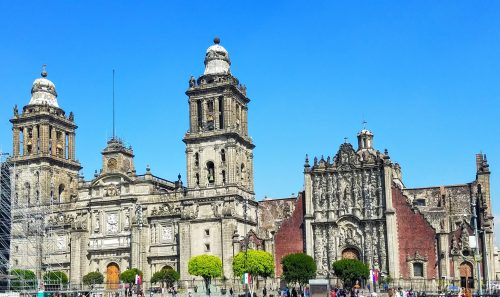
Disclosure: We enjoyed this tour as guests of Context Travel. I made no promise regarding the type of coverage I would provide. The opinions and observations expressed below are my own.
Our well traveled digital nomad son decided to put down roots in Mexico City. This was all the excuse Mr. Excitement and I needed for a repeat visit to this energetic megopolis. Our last visit to Mexico City was in 2012 when we wandered around by ourselves, including a visit to Mexico City’s historic center.
In reviewing our Mexico City tour options for our most recent visit, I was happy to learn that Context Travel expanded its tour offerings to include Mexico City day tours. We’ve enjoyed prior positive experiences with Context Travel docents (guides) in Rome, and in Edinburgh, Scotland in 2016, so I was anxious to see how we would feel about a Context travel tour experience in Mexico City.
Context Travel Tour Hallmarks
Context Travel distinguishes itself from the tour provider pack by providing “deep travel for the culturally and intellectually curious.” Their walking tours are for groups no larger than six. Customized private tours can also be arranged. The tours are led by docents who are masters or doctorate level experts in a field relevant to the particular tour.
Because of our travel schedule, the only Context Travel tour available to us was the three hour “The Making of Mexico” tour which includes some venues we had previously visited. We decided it would be interesting to see if the Context Travel Tour enhanced our appreciation of what we had experienced on our own.
“The Making of Mexico” Context Travel Walking Tour
The historic center of Mexico City is a complex, bustling place. Via an email from Context Travel, we received very detailed instructions about where to meet our docent, Ignacio Reyes Solis, in front of Mexico City’s main colonial era cathedral, including which cathedral gate to enter to look for a particular potted tree.
One thing every visitor to Mexico needs to understand is that the unanticipated is to be anticipated. Our first challenge was to figure out how to get to the appointed meeting place when the entrance we were to use was cordoned off for some type of maintenance. This is where speaking Spanish came in very handy. We found an alternative entrance to the massive cathedral and I was able to explain our predicament to the guard. He helpfully told us we could walk through the large cathedral to the appointed meeting place. He even agreed to be on the look-out for Ignacio and others on the tour so he could direct them.
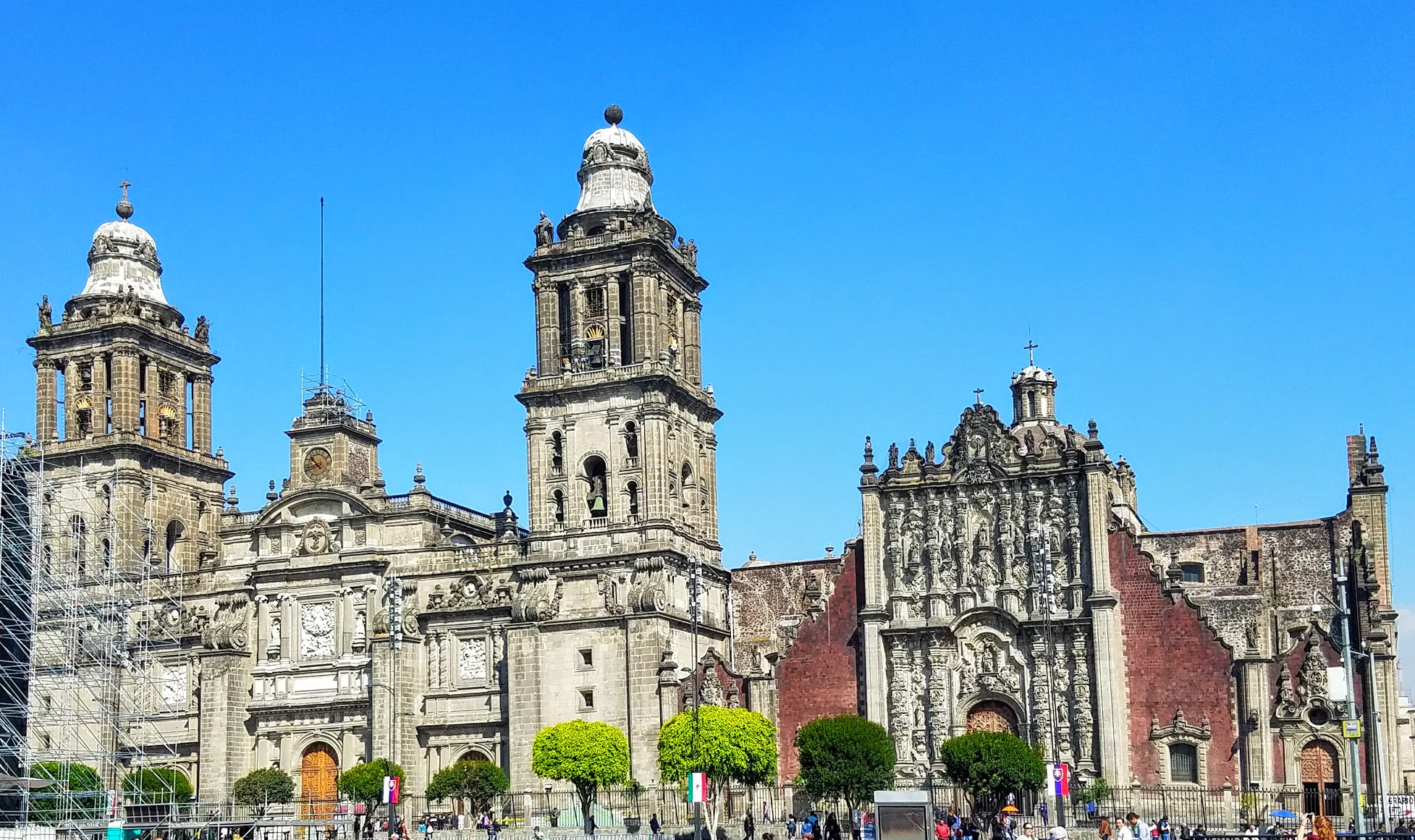
The massive Metropolitan Cathedral on the Zócalo (Constitution Plaza) in the historic Spanish colonial center of Mexico CIty. The facade on the far right best illustrates the Baroque features of the architecture. The cathedral was constructed between 1573 and 1813 in place of a church built at the order of Hernan Cortez in 1522.
By 9:05 a.m., we had all gathered at the appropriate place. There were six participants in our group for the tour, a young couple from London, a middle aged couple from Denver, and us who can only be considered middle aged if people start living to be over 120.
Ignacio is a young, personable architect who honed his competent English by doing a year of his program in Australia. His expertise in architecture was helpful, but what was most engaging for me was his command of the often fraught history of Mexico and the resultant struggle to define a national identity. He was also happy to supply those who asked with suggestions for local eating and nightlife.
El Templo Mayor
My first visit to Mexico City was in 1963 when I was nine. Feel free to do the math. At that time we visited the obviously sinking cathedral and were told that it had been built on unstable soil atop the main pyramid in the Aztec capital of Tenochtitlan. Wrong. Ignacio explained that in 1978, workers digging trenches for electricity cables found what archaeologists determined to be the remains of the Templo Mayor (principal temple) of the Aztecs next to, not under, the cathedral. There has been extensive archaeological excavation of the site even though it meant houses had to be destroyed.

In this photo, one can see 3 distinct aspects of the cultures that make up Mexico City. In the foreground are the ruins of the Aztec Templo Mayor site. Behind that is the Metropolitan Cathedral, built with stone from the Temple destroyed by the Spaniards in the 16th Century. In the distance, is one of the first 20th century sky scrapers built in Mexico City.
Ignacio bought our tickets to enter the site. Walkways around the ruins allow visitors to look down on the remains of what has been determined to have been a seven layered pyramid topped by temples to the Aztec gods of war and water. Adjacent to the Templo Mayor was a building used to house warriors while they studied religious matters. Paint is still visible in protected places in the ruins and Ignacio explained that the structures had been brilliantly painted.
Because of the early hour, we pretty much had the museum portion of the Templo Mayor site to ourselves. We walked through the museum with Ignacio as he explained the context and meaning of various artifacts, including legends surrounding large carved stone representations of Aztec gods. Ignacio also explained the lay out and methods of construction of Tenochtitlan and adjacent towns, and the rigid class hierarchy in Aztec society.
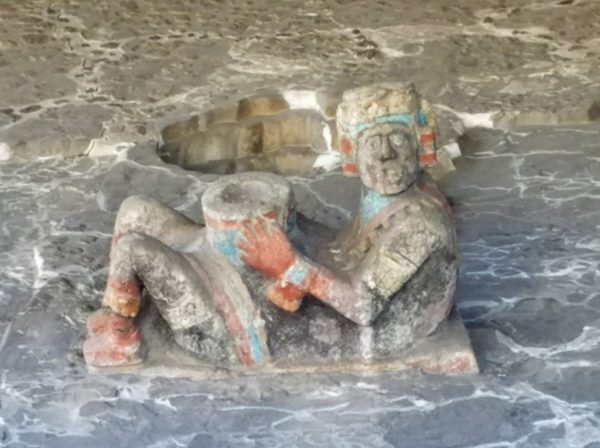
A chacmool found next to the Aztec Templo Mayor in Mexico City. It is thought that human hearts from sacrifices might have been placed in the bowl. The chacmool still retains some of the pigments from when it was brightly painted during the Aztec era.
Based on the written reports of the Spaniards who arrived with Cortez in 1519, it is thought that Tenochtitlan was then a city with a population of between 200,000 and 300,000, rivaling the size of Paris at that time. Ignacio explained that Cortez was able to augment his small Spanish force with warriors from other indigenous groups who had been conquered by the Aztecs and were being forced to pay tribute to the them. Smallpox also played its typically ugly role in assisting Europeans to defeat indigenous peoples.
After Ignacio managed to herd us out of the Museum of the Templo Mayor (remember, we were a group of intellectually and culturally curious people), the plan was for us to then visit the nearby National Palace, especially to see the murals of Diego Rivera covering the history of Mexico. Consistent with the national proclivity for the unanticipated, the building was closed to the public for the day due to a private event.
The Metropolitan Cathedral of the Assumption of the Most Blessed Virgin Mary into Heaven
We returned to visit the interior of the main metropolitan cathedral of Mexico City. Construction of a first church at the site started soon after Cortez’ conquered and destroyed the Aztec capital, Tenochtitlan, in 1521. Ignacio explained that it is the largest cathedral in the Americas. The cathedral has been sinking for centuries as it was constructed on waterlogged sandy and muddy land in the former lake that covered the center of what is now Mexico City. Ignacio explained the steps engineers and architects have taken to try to keep it from collapsing. He also pointed out the Baroque Churrigueresque and Plateresque styling of the ornate facade. We could not go on an extensive tour of the interior because a mass was in session, but we were able to see one of the impressive organs dating from the 18th century.
Gran Hotel Ciudad de Mexico
I don’t know if it’s a usual part of the Making of Mexico tour, but we stopped for beverages at a cafe near the historic Gran Hotel Ciudad de Mexico. Ignacio pointed out the Art Nouveau features on the facade of the 1899 building. The hotel permitted us to enter two at a time to view the ornate interior. The stained glass of the ceiling of the hotel atrium demanded a photo.

The stained glass ceiling of the atrium in the Gran Hotel Ciudad de Mexico in the historic center of Mexico City.
Small group tours can be heavily influenced by the chemistry of the group. Our coffee stop provided an opportunity for us to learn more about each other and for Ignacio to show us some pictorial representations of how the area where were sitting looked in 1519, before it was destroyed by the conquering Spaniards.
Palacio de las Bellas Artes
Ignacio then led us several blocks to the Palacio de las Bellas Artes, an opulent building completed in 1934 and used to host music, theater and exhibitions showcasing Mexico’s artistic traditions. Ignacio explained that the outside of the building showcases Neoclassical and Art Nouveau styling, while the interior exhibits Art Deco features.
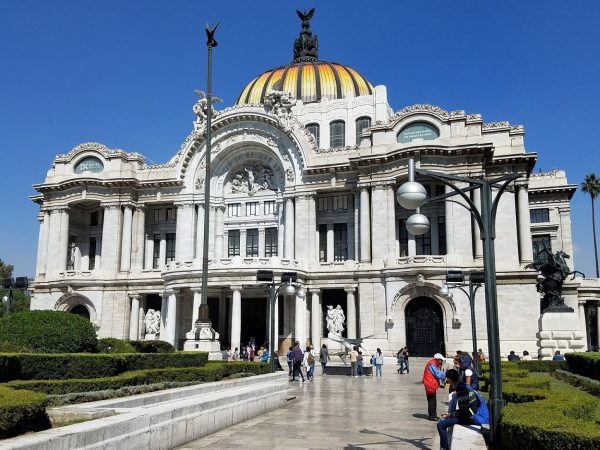
The opulent exterior of the Palacio de Bellas Artes in the center of Mexico City can’t be missed, especially when one is caught in a traffic jam right there as is often the case.
Along the way, Ignacio pointed out some of the earliest skyscrapers built in earthquake prone Mexico City. He explained the stricter building codes enforced after a deadly quake in 1985 that killed over 10,000 people and injured 30,000.
We were there soon after the serious 2017 earthquake. The wisdom of the stricter building codes was revealed by the fact that this time, far fewer lives were lost, 369 in a city with a population of close to 9 million. (The population of the Greater Mexico City economic area was reportedly 21,339,781 in 2015.)

The central portion of the 1947 Diego Rivera mural, Dream of a Sunday Afternoon in Alameda Central Park. Ignacio explained who many of the figures from Mexican history were in this extensive mural.
Ignacio paid a fee for us to be able to view a mural, Dream of a Sunday Afternoon in Alameda Park, by the famed Mexican muralist, Diego Rivera. I believe this mural may have been there for a special exhibition, borrowed from the Museo Mural de Diego Rivera. The mural spans the history of Mexico from the Conquest of Mexico by the Spaniards, through the fight for independence from Spain, the presidency of Porfirio Diaz, and the Mexican revolution of 1910. Ignacio explained the significance of many of the figures included in the mural. (Note: It was an additional 5 pesos if you wanted to be able to take photos or a video.)
Our tour ended after we viewed the mural. I wish Ignacio had suggested that we see some of the other murals in the building on our own. It’s possible that he did, but that I had wandered off, as other family members often unfairly accuse me of doing.
Conclusion
With the exception of the Templo Mayor Museum which we’ve now visited twice, I hope to return to study the other venues introduced by Ignacio more extensively. My only suggestion for this tour would be to expand it to four hours, so the various stops could be visited in greater depth. Ignacio’s narrative did add value to our appreciation and understanding and he patiently answered our many questions.
You Should Go on Context Travel’s “The Making of Mexico” Tour If:
- You are, in fact, culturally and intellectually curious. This tour is for people who prefer a more in depth explanation and analysis of what they are seeing. It would be helpful to do a little reading about the history of Mexico on one’s own before taking the tour.
- You can be on your feet standing and walking for three hours. There were at least some stairs involved in each venue except the Metropolitan Cathedral. I do not know if all the buildings were accessible for those with mobility problems. If that is an issue, I would recommend contacting Context Travel to inquire before booking this tour.
Travel Tip: Mexico City’s traffic is, in a word, loco. We used Uber to travel from our son’s condo in the Roma Norte section of Mexico City to the Metropolitan Cathedral where the tour started. However, we walked back (about an hour) because traffic seemed to be at a standstill. This tour is very convenient if you are staying in the center colonial district of Mexico City. Otherwise, ask someone where you are staying how they recommend you travel to the start of this tour and how long it will take to be there at 9:00 a.m.
We relied extensively on Uber for travel around Mexico City during our stay. We found it far more reliable than taxi service. It is also quite a bit less expensive than it is in our home city, Philadelphia.
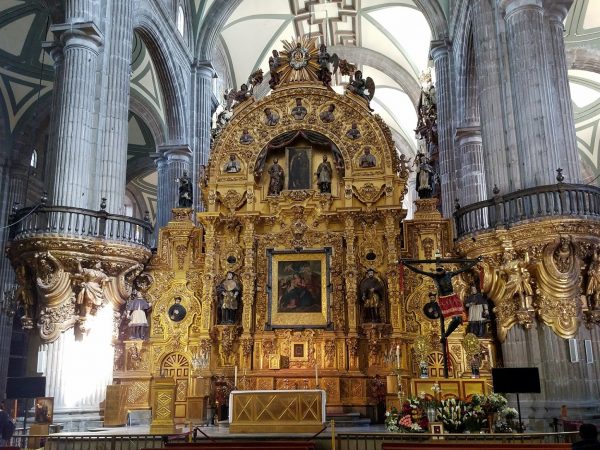
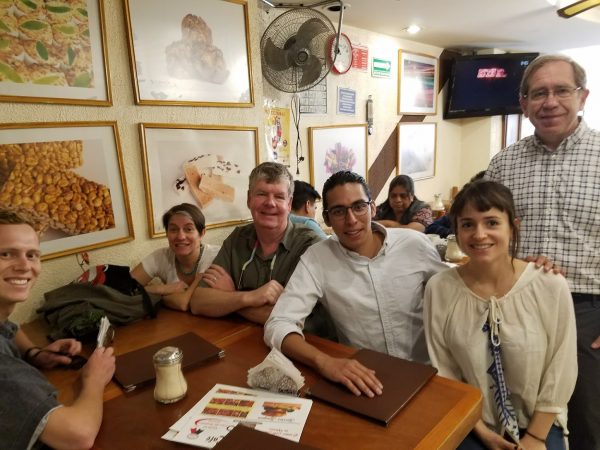
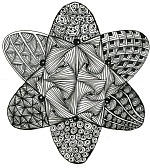

{ 17 comments… read them below or add one }
I’ve never visited Mexico City, but of course would love to. Context Travel walking tours would be something we’d definitely like to do. I think the whole ‘tick it off and move on’ mentality of modern tourism serves no-one – but a tour provider providing “deep travel for the culturally and intellectually curious,” in small groups would be a wonderful way to discover the city.
Thank you for your comment. It’s worth checking the Context Travel website the next time you will be visiting one of the world’s important cities. We have found the ones we’ve experienced to bring an added dimension to our touring.
I can see a Context Travel Tour in my future. What amazes me about this post is that those buildings were built so long ago and are still standing. Our modern buildings should be build so well! I love when you do a travel post and give me my vicarious living fix – thank you! I checked out your son’s page from last post links and wandered over to his Instagram page (nice butt, hoho, sorry) – he takes amazing pictures and tells tidbits about the pictures like his mama. Your family is truly fascinating and you and Mr. Excitement did an excellent job with your kiddos!
Very interesting tour, Suzanne. I visited Mexico City two years ago, but to no surprise, my focus was chocolate. I was thrilled with my findings, but am sure I would enjoy a Context walking tour as well.
My husband switched from coffee to hot chocolate as his morning beverage whole we were in Mexico.
You took me on a better tour than I did. Of course , I was only in Mexico City for a day and a half so I had to take in as much as I could in a short amount of time. I was able to take a tour of the Palacio de Las Artes but my city tour was a quick drive around the city. I would definitely like the extensive tour that Context Travel Gives.
I took a Context travel tour once in Athens and once in Barcelona: both were excellent. Having a tour guide with actual knowledge rather than a memorized routine makes all the difference. As for Mexico City, I’ve never been there, and I’d love to see those murals!
Before or after you see the murals in Mexico City, come to Philadelphia and go on a mural tour.
I’ve never taken a Context walking tour, but they sound wonderful. The amount of information provided sounds great and the places on this tour look fascinating. I’d like to visit Mexico City some day.
I’ve been on a Context tour before (in Athens) and it was a great way to get to know a place with a long and complex history. Mexico is pretty high on my bucket list so perhaps I’ll try the Mexico City tour when I eventually get there.
Super article. I lived in Mexico City for five years after graduating from High School. I loved it. I was reliving some of my experiences throughout your story.
Thank you for sharing.
It’s years since I visited Mexico City. You’ve renewed my resolve to put in on the 2018 calendar.
I particularly like the idea of the Context Travel Walking Tour. Of course, the architecture is a photographer’s dream, and small group tours have many advantages – particularly with a professional tour guide. That makes all the difference.
Well covered, and excellent pictures! Thank you.
I enjoyed revisiting the cathedral and El Templo Mayor with you through your story. Downtown Mexico City is filled with history. This is a little treat for you–ringing the hour on the cathedral bells, https://youtu.be/q9b_c09ULn8. Enjoy!
It sounds as though Context offers a really in-depth tour of Mexico City. I usually spend my time in the restaurants or markets so do need to branch out!
I was pleased to read Context Travel offers small groups and that they are available in several cities. With me it all depends on how much information I want on a specific site, but your tour seemed just about right in details and time. I am going to check out their website to see what other cities might be offered!!
Context offers tours in many cities, especially in Europe and the US.
Lovely Oh that will be great fun with such a tour in Mexico.
{ 5 trackbacks }